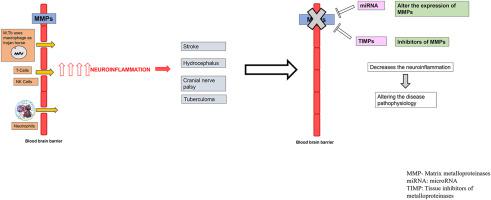当前位置:
X-MOL 学术
›
Tuberculosis
›
论文详情
Our official English website, www.x-mol.net, welcomes your feedback! (Note: you will need to create a separate account there.)
Role of MicroRNAs as post transcription regulators of matrix metalloproteinases and their association in tuberculous meningitis
Tuberculosis ( IF 3.2 ) Pub Date : 2024-03-05 , DOI: 10.1016/j.tube.2024.102501 Apoorva Aggarwal , Neeraj Singla , Monidipa Konar , Maninder Kaur , Kusum Sharma , Kajal Jain , Manish Modi , Sadhna Sharma
Tuberculosis ( IF 3.2 ) Pub Date : 2024-03-05 , DOI: 10.1016/j.tube.2024.102501 Apoorva Aggarwal , Neeraj Singla , Monidipa Konar , Maninder Kaur , Kusum Sharma , Kajal Jain , Manish Modi , Sadhna Sharma

|
Matrix metalloproteinases (MMPs) have a role in driving neuroinflammation in infectious as well as non-infectious diseases; however, recent reports have potentiated the role of microRNAs in regulating MMPs at post-transcriptional levels, leading to dysregulation of crucial MMP functions like tissue remodelling, blood brain barrier integrity, etc. In present study, microRNAs regulating MMPs (MMP2 and MMP3) were selected from database search followed by literature support. Expression of these microRNAs i.e., hsa-miR-495-3p, hsa-miR-132-3p and hsa-miR-21-5p was assessed by RT-PCR and the protein levels of MMPs were assessed by ELISA in the cerebrospinal fluid (CSF) of tuberculous meningitis (TBM) patients, healthy controls (HC) and non-infectious neuroinflammatory disease (NID) patients. The expression of hsa-miR-495-3p and hsa-miR-132-3p showed downregulation in TBM while hsa-miR-21-5p was overexpressed as compared to healthy controls. Moreover, MMP levels were found to be deranged with a significant increase in MMP3 levels in the TBM and NID patients compared to HC group. These observations highlight dysregulated microRNAs (hsa-miR-495-3p, hsa-miR-21-5p and hsa-miR-132-3p) levels might impair the levels of MMPs (MMP2 and MMP3) leading to neuroinflammation in TBM and NID population. These findings can further be applied to target these microRNAs for developing newer treatment modalities for better complication management.
中文翻译:

MicroRNA 作为基质金属蛋白酶转录后调节因子的作用及其在结核性脑膜炎中的关联
基质金属蛋白酶 (MMP) 在感染性和非感染性疾病中的神经炎症中发挥作用;然而,最近的报告强调了 microRNA 在转录后水平调节 MMP 的作用,导致重要的 MMP 功能失调,如组织重塑、血脑屏障完整性等。在本研究中,调节 MMP(MMP2 和 MMP3)的 microRNA从数据库检索和文献支持中选择。通过 RT-PCR 评估这些 microRNA(即 hsa-miR-495-3p、hsa-miR-132-3p 和 hsa-miR-21-5p)的表达,并通过 ELISA 评估脑脊液中 MMP 的蛋白水平。结核性脑膜炎(TBM)患者、健康对照(HC)和非传染性神经炎性疾病(NID)患者的脑脊液(CSF)。与健康对照相比,TBM 中 hsa-miR-495-3p 和 hsa-miR-132-3p 的表达下调,而 hsa-miR-21-5p 过表达。此外,与 HC 组相比,TBM 和 NID 患者的 MMP 水平出现紊乱,MMP3 水平显着升高。这些观察结果强调,失调的 microRNA(hsa-miR-495-3p、hsa-miR-21-5p 和 hsa-miR-132-3p)水平可能会损害 MMP(MMP2 和 MMP3)的水平,导致 TBM 和 NID 群体的神经炎症。这些发现可以进一步应用于靶向这些 microRNA,以开发更新的治疗方式,以实现更好的并发症管理。
更新日期:2024-03-05
中文翻译:

MicroRNA 作为基质金属蛋白酶转录后调节因子的作用及其在结核性脑膜炎中的关联
基质金属蛋白酶 (MMP) 在感染性和非感染性疾病中的神经炎症中发挥作用;然而,最近的报告强调了 microRNA 在转录后水平调节 MMP 的作用,导致重要的 MMP 功能失调,如组织重塑、血脑屏障完整性等。在本研究中,调节 MMP(MMP2 和 MMP3)的 microRNA从数据库检索和文献支持中选择。通过 RT-PCR 评估这些 microRNA(即 hsa-miR-495-3p、hsa-miR-132-3p 和 hsa-miR-21-5p)的表达,并通过 ELISA 评估脑脊液中 MMP 的蛋白水平。结核性脑膜炎(TBM)患者、健康对照(HC)和非传染性神经炎性疾病(NID)患者的脑脊液(CSF)。与健康对照相比,TBM 中 hsa-miR-495-3p 和 hsa-miR-132-3p 的表达下调,而 hsa-miR-21-5p 过表达。此外,与 HC 组相比,TBM 和 NID 患者的 MMP 水平出现紊乱,MMP3 水平显着升高。这些观察结果强调,失调的 microRNA(hsa-miR-495-3p、hsa-miR-21-5p 和 hsa-miR-132-3p)水平可能会损害 MMP(MMP2 和 MMP3)的水平,导致 TBM 和 NID 群体的神经炎症。这些发现可以进一步应用于靶向这些 microRNA,以开发更新的治疗方式,以实现更好的并发症管理。



























 京公网安备 11010802027423号
京公网安备 11010802027423号